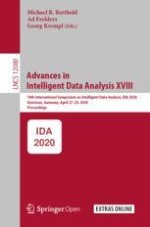Open Access 2020 | Open Access | Buch

Advances in Intelligent Data Analysis XVIII
18th International Symposium on Intelligent Data Analysis, IDA 2020, Konstanz, Germany, April 27–29, 2020, Proceedings
herausgegeben von: Prof. Dr. Michael R. Berthold, Ad Feelders, Georg Krempl
Verlag: Springer International Publishing
Buchreihe : Lecture Notes in Computer Science